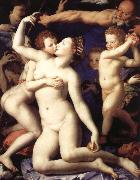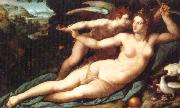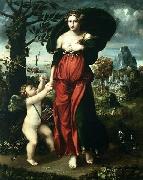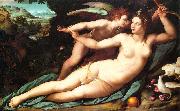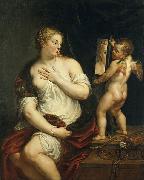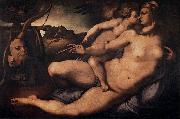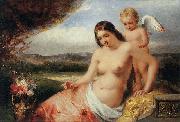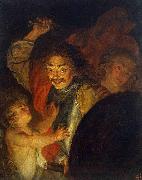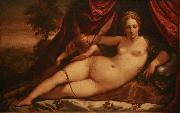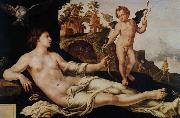Wholesale Oil Painting No Minimum |
|||||||||||
|
|
|||||||||||

|
|||||||||||
|
|
|
||||||||
ALLORI AlessandroItalian Mannerist Painter, 1535-1607 Born in Florence. After the death of his father in 1540 he was brought up and trained in art by a close friend, often referred to as his 'uncle', the mannerist painter Agnolo Bronzino, whose name he sometimes assumed in his pictures. In some ways, Allori is the last of the line of prominent Florentine painters, of generally undiluted Tuscan artistic heritage: Andrea del Sarto worked with Fra Bartolomeo (as well as Leonardo Da Vinci), Pontormo briefly worked under Andrea, and trained Bronzino, who trained Allori. Subsequent generations in the city would be strongly influenced by the tide of Baroque styles pre-eminent in other parts of Italy. Freedburg derides Allori as derivative, claiming he illustrates "the ideal of Maniera by which art (and style) are generated out of pre-existing art." The polish of figures has an unnatural marble-like form as if he aimed for cold statuary. It can be said of late phase mannerist painting in Florence, that the city that had early breathed life into statuary with the works of masters like Donatello and Michelangelo, was still so awed by them that it petrified the poses of figures in painting. While by 1600 the Baroque elsewhere was beginning to give life to painted figures, Florence was painting two-dimensional statues. Furthermore, in general, with the exception of the Contra Maniera artists, it dared not stray from high themes or stray into high emotion. |
||||||||
|
|
||||||||
Venus and Cupid
Venus and Cupid Painting ID:: 4693 |
Oil on wood
Mus??e Fabre, Montpellier Oil on wood Mus??e Fabre, Montpellier |
|||||||
|
|
||||||||
Jean Honore Fragonard1732-1806 French Jean Honore Fragonard Locations French painter. He studied with François Boucher in Paris c. 1749. He subsequently won a Prix de Rome, and while in Italy (1756 ?C 61) he traveled extensively and executed many sketches of the countryside, especially the gardens at the Villa d Este at Tivoli, and developed a great admiration for the work of Giovanni Battista Tiepolo. In 1765 his large historical painting Coresus Sacrifices Himself to Save Callirhoë was purchased for Louis XV and won Fragonard election to the French Royal Academy. He soon abandoned this style to concentrate on landscapes in the manner of Jacob van Ruisdael, portraits, and the decorative, erotic outdoor party scenes for which he became famous (e.g., The Swing, c. 1766). The gentle hedonism of such party scenes epitomized the Rococo style. Although the greater part of his active life was passed during the Neoclassical period, he continued to paint in a Rococo idiom until shortly before the French Revolution, when he lost his patrons and livelihood. |
||||||||
|
|
||||||||
|
|
Venus and Cupid
Venus and Cupid Painting ID:: 29534 |
c. 1760
Oil on canvas, 37 x 34 cm c. 1760 Oil on canvas, 37 x 34 cm |
||||||
|
|
||||||||
ALLORI AlessandroItalian Mannerist Painter, 1535-1607 Born in Florence. After the death of his father in 1540 he was brought up and trained in art by a close friend, often referred to as his 'uncle', the mannerist painter Agnolo Bronzino, whose name he sometimes assumed in his pictures. In some ways, Allori is the last of the line of prominent Florentine painters, of generally undiluted Tuscan artistic heritage: Andrea del Sarto worked with Fra Bartolomeo (as well as Leonardo Da Vinci), Pontormo briefly worked under Andrea, and trained Bronzino, who trained Allori. Subsequent generations in the city would be strongly influenced by the tide of Baroque styles pre-eminent in other parts of Italy. Freedburg derides Allori as derivative, claiming he illustrates "the ideal of Maniera by which art (and style) are generated out of pre-existing art." The polish of figures has an unnatural marble-like form as if he aimed for cold statuary. It can be said of late phase mannerist painting in Florence, that the city that had early breathed life into statuary with the works of masters like Donatello and Michelangelo, was still so awed by them that it petrified the poses of figures in painting. While by 1600 the Baroque elsewhere was beginning to give life to painted figures, Florence was painting two-dimensional statues. Furthermore, in general, with the exception of the Contra Maniera artists, it dared not stray from high themes or stray into high emotion. |
||||||||
|
|
||||||||
|
|
Venus and Cupid
Venus and Cupid Painting ID:: 32226 |
Oil on wood Oil on wood |
||||||
|
|
||||||||
Lorenzo LottoItalian 1480-1556 Lorenzo Lotto Galleries In this last period of his life, Lorenzo Lotto would frequently move from town to town, searching for patrons and commissions. In 1532 he went to Treviso. Next he spent about seven years in the Marches (Ancona, Macerata en Jesi), returning to Venice in 1540. He moved again to Treviso in 1542 and back to Venice in 1545. Finally he went back to Ancona in 1549. This was a productive period in his life, during which he painted several altarpieces and portraits : Santa Lucia before the Judge, 1532, Jesi, Pinacoteca comunale The Sleeping Child Jesus with the Madonna, St. Joseph and St. Catherine of Alexandria, 1533, Bergamo, Accademia Carrara Portrait of a Lady as Lucretia, 1533, National Gallery, London. Holy Family with SS Jerome, Anna and Joachim, 1534, Firenze, Uffizi Holy Family, ca 1537, Paris, Louvre Portrait of a Young Man, Firenze, Uffizi Crucifixion, Monte San Giusto, Church of S Maria in Telusiano Rosary Madonna, 1539, Cingoli, Church of San Nicolo Portrait of a Man, 1541, Ottawa, National Gallery of Canada Bust of a Bearded Man, 1541, ascribed, San Francisco, Fine Arts Museum The Alms of Saint Anthony, 1542, Venezia, church SS Giovanni e Paolo Madonna and four Saints, 1546, Venezia, Church of San Giacomo dell??Orio Portrait of fra?? Gregorio Belo da Vicenza, 1548,New York, Metropolitan Museum Assumption, 1550, Ancona, church San Francesco alle Scale The Crossbowman, 1551, Rome, Pinacoteca Capitolina Portrait of an Old man, ascribed, ca 1552, Saint Petersburg, Ermitage Presentation in the Temple, 1555, Loreto, Palazzo Apostolico A Venetian woman in the guise of Lucretia (1533).At the end of his life it was becoming increasingly difficult for him to earn a living. Furthermore, in 1550 one of his works had an unsuccessful auction in Ancona. As recorded in his personal account book, this deeply disillusioned him. As he had always been a deeply religious man, he entered in 1552 the Holy Sanctuary at Loreto, becoming a lay brother. During that time he decorated the basilica of S Maria and painted a Presentation in the Temple for the Palazzo Apostolico in Loreto. He died in 1556 and was buried, at his request, in a Dominican habit. Giorgio Vasari included Lotto's biography in the third volume of his book Vite. Lorenzo Lotto himself left many letters and a detailed notebook (Libro di spese diverse, 1538-1556), giving a certain insight in his life and work. Among the many painters he influenced are likely Giovanni Busi |
||||||||
|
|
||||||||
|
|
Venus and Cupid
Venus and Cupid Painting ID:: 32560 |
mk79
About 1530
mk79 About 1530 |
||||||
|
|
||||||||
Lucas Cranach the Elderb. 1472, Kronach, d. 1553, Weimar. German painter and printmaker. He took his name from the town of his birth. Little is known about his early life or training. In Vienna (c. 1501 ?C 04) he painted some notable portraits and landscapes characteristic of the Danube school. From 1505 to 1550 he was court painter in Wittenberg, where he achieved great success and wealth painting portraits, mythological subjects, and altarpieces for Protestant and Catholic churches. He attracted so many young artists to Wittenberg that the town became an art centre. A friend of Martin Luther, Cranach became known as the chief pictorial propagandist of the Protestant cause in Germany. He produced numerous engravings and more than 100 woodcuts, notably for the first German edition of the New Testament (1522). After his death, his style was perpetuated by his son, Lucas the Younger (1515 C 86). |
||||||||
|
|
||||||||
|
|
Venus and Cupid
Venus and Cupid Painting ID:: 40302 |
mk156
1509
Oil on canvas transferred from wood
213x102cm
mk156 1509 Oil on canvas transferred from wood 213x102cm |
||||||
|
|
||||||||
CRANACH, Lucas the ElderGerman painter (b. 1472, Kronach, d. 1553, Weimar). German painter and engraver. The son of a painter, he settled in Wittenberg c.1504 and was court painter successively under three electors of Saxony. There he maintained a flourishing workshop and was twice burgomaster. Cranach was a close friend of Martin Luther, whose doctrine he upheld in numerous paintings and woodcuts, and he has been called the painter of the Reformation. He was a rapid and prolific painter, and the work turned out by his studio is uneven in quality. Naïve and fanciful, often awkward in draftsmanship, it has, nonetheless, freshness and originality and a warm, rich palette. His portraits are particularly successful. Among his best-known works are Repose in Egypt (Gemäldgalerie, Staatliche Mus., Berlin-Dahlem); Judgment of Paris (Staatliche Kunsthalle, Karlsruhe); Adam and Eve (Courtauld Inst., London); and Crucifixion (Weimar). The latter contains figures of Luther and Cranach. His many famous protraits include those of Elector John Frederick and Self-Portrait (Uffizi). Cranach was also an accomplished miniaturist. He produced a few copperplates and designs for woodcuts. His son and pupil Lucas Cranach, the Younger, 1515C86, |
||||||||
|
|
||||||||
|
|
Venus and Cupid
Venus and Cupid Painting ID:: 42957 |
mk170
circa 1530
oil on wood
82.1x55.8cm
mk170 circa 1530 oil on wood 82.1x55.8cm |
||||||
|
|
||||||||
Jules PascinBulgarian-born French Expressionist Painter, 1885-1930,American painter, draughtsman and printmaker of Bulgarian birth, active in France. He attended secondary school in Vienna, returning in 1901 to Bucharest, where his family had settled, and working briefly in the office of his father's grain-merchandizing business. He was, however, already becoming passionately interested in drawing, for which he showed precocious talent. At the age of 16 he became the lover of a woman who ran a brothel and was allowed by her to draw the residents. In 1903 he moved to Munich, where he attended the art school run by Moritz Heymann. |
||||||||
|
|
||||||||
|
|
Venus and Cupid
Venus and Cupid Painting ID:: 51572 |
mk219
17.5x17cm
1924
mk219 17.5x17cm 1924 |
||||||
|
|
||||||||
GOSSAERT, Jan (Mabuse)Flemish Northern Renaissance Painter, ca.1478-1532 |
||||||||
|
|
||||||||
|
|
Venus and Cupid
Venus and Cupid Painting ID:: 52339 |
1521 Panel, 36 x 32,5 cm 1521 Panel, 36 x 32,5 cm |
||||||
|
|
||||||||
Agnolo BronzinoItalian Mannerist Painter, 1503-1572 Agnolo di Cosimo (November 17, 1503 ?C November 23,1572), usually known as Il Bronzino, or Agnolo Bronzino (mistaken attempts also have been made in the past to assert his name was Agnolo Tori and even Angelo (Agnolo) Allori), was an Italian Mannerist painter from Florence. The origin of his nickname, Bronzino is unknown, but could derive from his dark complexion, or from that he gave many of his portrait subjects. It has been claimed by some that he had dark skin as a symptom of Addison disease, a condition which affects the adrenal glands and often causes excessive pigmentation of the skin. |
||||||||
|
|
||||||||
|
|
Venus and Cupid
Venus and Cupid Painting ID:: 62079 |
mk276 1540 Oil on canvas 147 x 117cm National Gallery, London mk276 1540 Oil on canvas 147 x 117cm National Gallery, London |
||||||
|
|
||||||||
|
|
||||||||
|
|
Venus and Cupid
Venus and Cupid Painting ID:: 62080 |
mk276 Oil on canvas mk276 Oil on canvas |
||||||
|
|
||||||||
|
|
||||||||
|
|
Venus and Cupid
Venus and Cupid Painting ID:: 69667 |
oil on canvas painting by Battista Dossi oil on canvas painting by Battista Dossi |
||||||
|
|
||||||||
Alessandro Allori(May 3, 1535 - September 22, 1607) was an Italian portrait painter of the late Mannerist Florentine school. Born in Florence, in 1540, after the death of his father, he was brought up and trained in art by a close friend, often referred to as his 'uncle', the mannerist painter Agnolo Bronzino, whose name he sometimes assumed in his pictures. In some ways, Allori is the last of the line of prominent Florentine painters, of generally undiluted Tuscan artistic heritage: Andrea del Sarto worked with Fra Bartolomeo (as well as Leonardo Da Vinci), Pontormo briefly worked under Andrea, and trained Bronzino, who trained Allori. Subsequent generations in the city would be strongly influenced by the tide of Baroque styles pre-eminent in other parts of Italy. |
||||||||
|
|
||||||||
|
|
Venus and Cupid
Venus and Cupid Painting ID:: 84656 |
Date second half of 16th century
Medium Oil on wood
cjr Date second half of 16th century Medium Oil on wood cjr |
||||||
|
|
||||||||
Peter Paul RubensFlemish Baroque Era Painter, 1577-1640 Peter Paul Rubens (June 28, 1577 ?C May 30, 1640) was a prolific seventeenth-century Flemish Baroque painter, and a proponent of an exuberant Baroque style that emphasized movement, color, and sensuality. He is well-known for his Counter-Reformation altarpieces, portraits, landscapes, and history paintings of mythological and allegorical subjects. In addition to running a large studio in Antwerp which produced paintings popular with nobility and art collectors throughout Europe, Rubens was a classically-educated humanist scholar, art collector, and diplomat who was knighted by both Philip IV, king of Spain, and Charles I, king of England. Rubens was a prolific artist. His commissioned works were mostly religious subjects, "history" paintings, which included mythological subjects, and hunt scenes. He painted portraits, especially of friends, and self-portraits, and in later life painted several landscapes. Rubens designed tapestries and prints, as well as his own house. He also oversaw the ephemeral decorations of the Joyous Entry into Antwerp by the Cardinal-Infante Ferdinand in 1635. His drawings are mostly extremely forceful but not detailed; he also made great use of oil sketches as preparatory studies. He was one of the last major artists to make consistent use of wooden panels as a support medium, even for very large works, but he used canvas as well, especially when the work needed to be sent a long distance. For altarpieces he sometimes painted on slate to reduce reflection problems. His fondness of painting full-figured women gave rise to the terms 'Rubensian' or 'Rubenesque' for plus-sized women. The term 'Rubensiaans' is also commonly used in Dutch to denote such women. |
||||||||
|
|
||||||||
|
|
Venus and Cupid
Venus and Cupid Painting ID:: 88529 |
Around 1606-1611
Medium Oil on canvas
Dimensions Height: 137 cm (53.9 in). Width: 111 cm (43.7 in).
cjr Around 1606-1611 Medium Oil on canvas Dimensions Height: 137 cm (53.9 in). Width: 111 cm (43.7 in). cjr |
||||||
|
|
||||||||
Sebastiano Ricci(1 August 1659 - 15 May 1734) was an Italian painter of the late Baroque school of Venice. About the same age as Piazzetta, and an elder contemporary of Tiepolo, he represents a late version of the vigorous and luminous Cortonesque style of grand manner fresco painting. He was born in Belluno, son of Andreana and Livio Ricci. In 1671, he apprenticed to Federico Cerebri of Venice. Others claim Ricci's first master was Sebastiano Mazzoni. In 1678, a youthful indiscretion led to an unwanted pregnancy, and ultimately to a greater scandal, when Ricci was accused of attempting to poison the young pregnant woman to avoid marriage. Imprisoned, he gained release only after intervention of a nobleman, probably a Pisani family member. He married the pregnant mother in 1691, although this was a stormy union. After his arrest, he moved to Bologna, where he domiciled near the Parish of San Michele del Mercato. His painting style there was apparently influenced by Giovanni Gioseffo dal Sole. On 28 September 1682 he was contracted by the "Fraternity of Saint John of Florence" to paint a Decapitation of John the Baptist for their Oratory. On 9 December 1685, the Count of San Segundo near Parma commissioned from Ricci the decoration of the Oratory of the Madonna of the Seraglio, which he completed in collaboration of Ferdinando Galli-Bibiena by October 1687, receiving a compensation of 4,482 Lira. |
||||||||
|
|
||||||||
|
|
Venus and Cupid
Venus and Cupid Painting ID:: 90488 |
Oil on canvas. 72 x 97 cm.
Date c. 1700
cyf Oil on canvas. 72 x 97 cm. Date c. 1700 cyf |
||||||
|
|
||||||||
Lucas Cranach the Elderb. 1472, Kronach, d. 1553, Weimar. German painter and printmaker. He took his name from the town of his birth. Little is known about his early life or training. In Vienna (c. 1501 ?C 04) he painted some notable portraits and landscapes characteristic of the Danube school. From 1505 to 1550 he was court painter in Wittenberg, where he achieved great success and wealth painting portraits, mythological subjects, and altarpieces for Protestant and Catholic churches. He attracted so many young artists to Wittenberg that the town became an art centre. A friend of Martin Luther, Cranach became known as the chief pictorial propagandist of the Protestant cause in Germany. He produced numerous engravings and more than 100 woodcuts, notably for the first German edition of the New Testament (1522). After his death, his style was perpetuated by his son, Lucas the Younger (1515 C 86). |
||||||||
|
|
||||||||
|
|
Venus and Cupid
Venus and Cupid Painting ID:: 91132 |
1509(1509)
Medium Oil on canvas transferred from wood
Dimensions Height: 213 cm (83.9 in). Width: 102 cm (40.2 in).
cyf 1509(1509) Medium Oil on canvas transferred from wood Dimensions Height: 213 cm (83.9 in). Width: 102 cm (40.2 in). cyf |
||||||
|
|
||||||||
Jacopo PontormoItalian 1494-1557 Jacopo Pontormo Galleries Italian painter and draughtsman. He was the leading painter in mid-16th-century Florence and one of the most original and extraordinary of Mannerist artists. His eccentric personality, solitary and slow working habits and capricious attitude towards his patrons are described by Vasari; his own diary, which covers the years 1554-6, further reveals a character with neurotic and secretive aspects. Pontormo enjoyed the protection of the Medici family throughout his career but, unlike Agnolo Bronzino and Giorgio Vasari, did not become court painter. His subjective portrait style did not lend itself to the state portrait. He produced few mythological works and after 1540 devoted himself almost exclusively to religious subjects. His drawings, mainly figure studies in red and black chalk, are among the highest expressions of the great Florentine tradition of draughtsmanship; close to 400 survive, forming arguably the most important body of drawings by a Mannerist painter. His highly personal style was much influenced by Michelangelo, though he also drew on northern art, primarily the prints of Albrecht Derer. |
||||||||
|
|
||||||||
|
|
Venus and Cupid
Venus and Cupid Painting ID:: 91180 |
between 1532(1532) and 1534(1534)
Medium oil on panel
cyf between 1532(1532) and 1534(1534) Medium oil on panel cyf |
||||||
|
|
||||||||
William Edward frost R.A.1810-1877 was an English painter of the Victorian era. Virtually alone among English artists in the middle Victorian period, he devoted his practice to the portrayal of the female nude. Frost was educated in the schools of the Royal Academy, beginning in 1829; he established a reputation as a portrait painter before branching into historical and mythological subjects, including the sub-genre of fairy painting that was characteristic of Victorian art. In 1839 he won the Royal Academy's gold medal for his "Prometheus Bound," and in 1843 he won a prize in the Westminster Hall competition for his "Una Alarmed by Fauns" (a subject from Spenser's The Faerie Queen). He was elected an associate member of the Royal Academy in 1846, and a full member in 1870. Frost is widely recognized as a follower of William Etty, who preceded him as the primary British painter of nudes in the second quarter of the nineteenth century. |
||||||||
|
|
||||||||
|
|
Venus and Cupid
Venus and Cupid Painting ID:: 94603 |
oil on canvas
Dimensions 31,8 x 46,4 cm
cjr oil on canvas Dimensions 31,8 x 46,4 cm cjr |
||||||
|
|
||||||||
Joachim von Sandrart(12 May 1606 - 14 October 1688) was a German Baroque art-historian and painter, active in Amsterdam during the Dutch Golden Age. Sandrart was born in Frankfurt, but the family originated from Mons. According to Houbraken (who used his Teutsche Akademie as a primary source), he learned to read and write from the son of Theodor de Bry, Johann Theodoor de Brie and his associate Matthäus Merian, but at age 15 was so eager to learn more of the art of engraving, that he walked from Frankfurt to Prague to become a pupil of Gillis Sadelaar (also known as Aegidius Sadeler of the Sadeler family). Sadelaar in turn urged him to paint, whereupon he travelled to Utrecht in 1625 to become a pupil of Gerrit van Honthorst, and through him he met Rubens when he brought a visit to Honthorst in 1627, to recruit him for collaboration on part of his Marie de' Medici cycle. Honthorst took Sandrart along with him when he travelled to London. There he worked with Honthorst and spent time making copies of Holbein portraits for the portrait gallery of Henry Howard, 22nd Earl of Arundel. Making all of those copies only served to arouse more curiosity in the young adventurer, and in 1627 Sandrart booked a passage on a ship from London to Venice, where he was welcomed by Jan Lis (whose Bentvueghels bent name was "Pan"), and Nicolaas Ringnerus. He then set out for Bologna, where he was met by his cousin on his father's side Michael le Blond, a celebrated engraver. With him, he crossed the mountains to Florence, and from there on to Rome, where they met Pieter van Laer (whose bent name was "Bamboccio"). Sandrart became famous as a portrait-painter. After a few years he undertook a tour of Italy, traveling to Naples, where he drew studies of Mount Vesuvius, believed to be the entrance to the Elysian fields described by Virgil. From there he traveled to Malta and beyond, searching for literary sights to see and paint, and wherever he went he paid his way by selling portraits. Only when he was done traveling did he finally return to Frankfurt, where he married Johanna de Milkau. Afraid of political unrest and plague, he moved to Amsterdam with his wife in 1637. |
||||||||
|
|
||||||||
|
|
Venus and Cupid
Venus and Cupid Painting ID:: 95442 |
circa 1630(1630)
Medium oil on canvas
cyf circa 1630(1630) Medium oil on canvas cyf |
||||||
|
|
||||||||
BRAMANTEItalian High Renaissance Architect and Painter, 1444-1514 In the first decade of the 16th century Donato Bramante was the chief architect in Rome, which had just replaced Florence as the artistic capital of Europe because the patronage of Pope Julius II (reigned 1503-1513) attracted all the leading Italian artists to that city. It is particularly the triumvirate of artists - Michelangelo the sculptor and painter, Raphael the painter, and Bramante the architect - who dominated this period, usually called the High Renaissance, and whose influence overwhelmed the following generations. Donato di Pascuccio d'Antonio, called Bramante, was born in 1444 at Monte Asdruvaldo near Urbino. Nothing is known of the first 30 years of his life. During that period, however, the court of Federigo da Montefeltro at Urbino was a flourishing humanistic and cultural center, attended by artists such as Piero della Francesca, Melozzo da Forll, and Luciano Laurana, who probably influenced the young Bramante. The first notice of Bramante dates from 1477, when he decorated the facade of the Palazzo del Podestaat Bergamo with a frescoed frieze of philosophers. |
||||||||
|
|
||||||||
|
|
Venus and Cupid
Venus and Cupid Painting ID:: 97947 |
Oil on Canvas. Found in Germany after the Second World War. Accession number: 1867 or MNR 16
cyf Oil on Canvas. Found in Germany after the Second World War. Accession number: 1867 or MNR 16 cyf |
||||||
|
|
||||||||
Maarten van Heemskerck(1498 - 1 October 1574) was a Dutch portrait and religious painter, known for his depictions of the Seven Wonders of the World. He was born at Heemskerk, North Holland, halfway between Alkmaar and Haarlem. His father was a small farmer, Jacob Willemsz. van Veen (whose portrait he painted). According to his biography, written by Karel van Mander, he was apprenticed to Cornelis Willemsz in Haarlem. Recalled after a time to the paternal homestead and put to the plough or the milking of cows, young Heemskerk took the first opportunity that offered to run away, and demonstrated his wish to leave home for ever by walking in a single day the 80 km which separate his native hamlet from the town of Delft. There he studied under Jan Lucasz whom he soon deserted for his contemporary Jan van Scorel of Haarlem. Even today, many of Heemskerck's paintings are mistaken for work by van Scorel. He boarded at the home of the wealthy Pieter Jan Foppesz (the van Mander spelling is Pieter Ian Fopsen), curate of the Sint-Bavokerk. He knew him because he owned a lot of land in Heemskerck. This is the same man whom he painted in a now famous family portrait, considered the first of its kind in a long line of Dutch family paintings. |
||||||||
|
|
||||||||
|
|
Venus and Cupid
Venus and Cupid Painting ID:: 97960 |
1545(1545)
Medium oil on panel
cyf 1545(1545) Medium oil on panel cyf |
||||||
|
|
||||||||
|
Maarten van Heemskerck (1498 - 1 October 1574) was a Dutch portrait and religious painter, known for his depictions of the Seven Wonders of the World. He was born at Heemskerk, North Holland, halfway between Alkmaar and Haarlem. His father was a small farmer, Jacob Willemsz. van Veen (whose portrait he painted). According to his biography, written by Karel van Mander, he was apprenticed to Cornelis Willemsz in Haarlem. Recalled after a time to the paternal homestead and put to the plough or the milking of cows, young Heemskerk took the first opportunity that offered to run away, and demonstrated his wish to leave home for ever by walking in a single day the 80 km which separate his native hamlet from the town of Delft. There he studied under Jan Lucasz whom he soon deserted for his contemporary Jan van Scorel of Haarlem. Even today, many of Heemskerck's paintings are mistaken for work by van Scorel. He boarded at the home of the wealthy Pieter Jan Foppesz (the van Mander spelling is Pieter Ian Fopsen), curate of the Sint-Bavokerk. He knew him because he owned a lot of land in Heemskerck. This is the same man whom he painted in a now famous family portrait, considered the first of its kind in a long line of Dutch family paintings. Venus and Cupid 1545(1545) Medium oil on panel cyf |
||||||||
|
|
||||||||
|
Prev Next
|
||||||||
|
|
||||||||
|
Related Paintings to Maarten van Heemskerck :. |
||||||||
|
|
||||||||
|
CONTACT US |


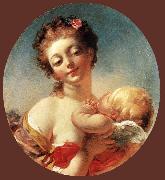
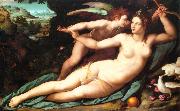
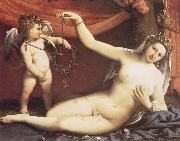

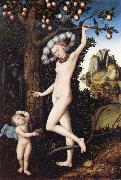
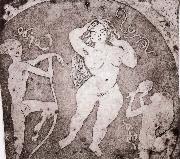
-459974.jpg)
